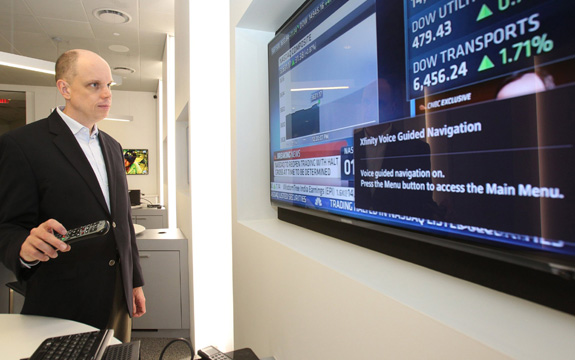With Eye On Disabilities, TV Gaining New Features

Tom Wlodkowski, a Comcast Corp. executive who is blind, demonstrates new features the company is rolling out designed to make television more accessible for people with disabilities. (Charles Fox/Philadelphia Inquirer/TNS)
When Comcast rolled out its Xfinity X1 cable boxes a few years ago, customers’ viewing experience took a major leap with a more-attractive interface, easier-to-navigate menus and other on-screen cues.
But such eye candy is of limited use to Comcast users who are blind or visually impaired.
Now the cable-television provider is taking a huge step to remedy this with the “X1 Talking Guide,” which it describes as “the industry’s first voice-enabled television user interface.”
Advertisement - Continue Reading Below
The guide features a female voice that reads aloud crucial TV-viewing information, such as show titles and network names. The voice serves as a guide as users hop from section to section — including the show guide, recorded-show queue, on-demand directory and cable-box settings.
“As you move across the menu bar, whatever is highlighted gets announced,” said Tom Wlodkowski, a Comcast executive who spearheaded the project, and who happens to be blind. “As you move horizontally across the program guide, it gives you the time, and as you move vertically within the grid it announces the new channel.”
The voice reads aloud such things as show descriptions, the time remaining on a show, the price of a film rental, and ratings from Common Sense Media and Rotten Tomatoes. The Talking Guide also specifies which buttons the viewer should press on the remote while navigating menus.
X1 users will be able to activate the Talking Guide by tapping the remote’s “A” button twice, or via the accessibility controls in the main settings menu. The option may not be available immediately, but Comcast said the Talking Guide should be broadly deployed by early December. All X1 users are set to get it eventually via automatic updates.
A company division dubbed the Comcast Accessibility Lab has been at work on the Talking Guide for more than a year as part of its broader mission to make Comcast technology more accessible to those with disabilities.
The Talking Guide remains a work in progress. Philadelphia-based Comcast said it will integrate searching capabilities into a future upgrade, along with the option to speed up or slow down the guide’s voice prompts.
The Talking Guide also helps unearth features for those with visual impairment that have been there all along, but were not easy to access. Some shows include auxiliary audio — also called “second audio program” or SAP — that describes what is happening on the screen for those who cannot see it. Getting at this feature via the Talking Guide is relatively straightforward, Comcast said.
SAP is available with roughly 50 hours of programming per quarter from each of the four major networks as well as from USA, Disney Channel, Nickelodeon, TNT and TBS channels, it noted.
The Talking Guide is among a range of voice-related capabilities Comcast is perfecting. Others include the XR11 Voice Control Remote, which includes a microphone to issue spoken commands such as “record,” “show me films about baseball” or “turn on closed captions.” The company said it expects to release the remote later this year.
Comcast’s mobile apps can tap into VoiceOver and Talkback, which are screen-reading features built into the Apple iOS and Google Android operating systems.
Comcast, in addition to creating new technology, said it runs a support center for the people with disabilities that fields about 10,000 calls per month.
Read more stories like this one. Sign up for Disability Scoop's free email newsletter to get the latest developmental disability news sent straight to your inbox.


